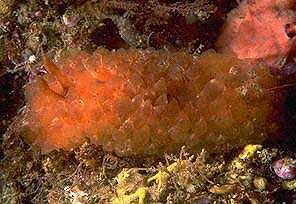
Galeojanolus ioannae
Miller, 1971
Order: NUDIBRANCHIA
Suborder: ARMININA
Family: Zephyrinidae
DISTRIBUTION
With records from Otago, in the south of the South Island, to Leigh, north of Auckland, this species probably occurs throughout New Zealand. It is very rare intertidally, mainly found subtidally to about 20m where it can be quite common.
PHOTO
Nursery Cove, Poor Knights Islands, New Zealand, 12m, January 1998.
PHOTO:Ross and Diane Armstrong.
Grows to about 60mm long.
Reference:
• Miller, M.C. (1971). A new genus and species of the nudibranch family Janolidae (Mollusca; Gastropoda, Opisthobranchia) from New Zealand waters. Journal of Natural History, 5: 491-498
Rudman, W.B., 1998 (August 10) Galeojanolus ioannae Miller, 1971. [In] Sea Slug Forum. Australian Museum, Sydney. Available from http://www.seaslugforum.net/find/galeoion
Related messages
Galeojanolus and Philine
August 11, 1998
From: Richard Willan
Dear Bill,
I hadn't looked at your slug forum for some time, so your request this morning for me to look at the zephyrinid from New Zealand gave me a chance to read the latest items and catch up on all that has passed regarding Philine auriformis.
The zephyrinid is definitely Galeojanolus ionnae. Janolus ignis would be the only other similar species from New Zealand, but that has lilac blue markings on the body and the cerata are neither swollen nor pustulose.
The correct identity of the Philine from California has considerable significance back in this country. The name Philine auriformis appears on the List of marine species that pose a threat to Australia (Appendix 2.2) published by Hewitt & Martin (1996) in CRIMP Technical Report No. 4. Even given the problems with identification, I doubt this opisthobranch could really pose much of a nationwide threat! I wonder where that name came from and why it was chosen for listing like this?
Some time I need to examine the large white Philine which is common up here in Darwin Harbour. Externally it looks just like P. angasi.
Cheers,
Richard
Richard Willan
Northern Territory Museum
Darwin, Australia.
Richard.Willan@DWNMUS.MAGNT.nt.gov.au
Willan, R., 1998 (Aug 11) Galeojanolus and Philine. [Message in] Sea Slug Forum. Australian Museum, Sydney. Available from http://www.seaslugforum.net/find/206Thanks for the confirmation of Galeojanolus.
Nudibranch from New Zealand.
August 10, 1998
From: Ross & Diane Armstrong

Hi
My wife and I photographed this (we assume it is a nudibranch) on a night dive in Nursery Cove at the Poor Knights Islands on 31 January 1998. The depth was about 12m.
We have been unable to identify it.
cheers
Ross and Diane Armstrong
ross@northpower.co.nz
Armstrong, R. & D., 1998 (Aug 10) Nudibranch from New Zealand.. [Message in] Sea Slug Forum. Australian Museum, Sydney. Available from http://www.seaslugforum.net/find/196This is a species of nudibranch belonging to the Suborder Arminina. Some of the more common genera you will find illustrated in books are Caldukia, Madrella and Janolus. The zephyrinids feed on encrusting and arborescent bryozoans (lace corals) and appear to be fairly specialised feeders, each species specialising on a particular food species. We don't know what this species feeds on.
Zephyrinids all have tapering tubular cerata on their backs, much like the aeolids. In many species the cerata can be cast by the animal when it is disturbed.
I am not totally confident of my species identification, but hopefully, Richard Willan, who is an expert on this group in New Zealand, will see this and confirm or correct my identification.
Galeojanolus ionnae differs from other zephyrinids by having somewhat swollen pustulose cerata but it is difficult to be sure from your photo.
Unfortunately a hiccup in our computer cutoff your email address. Could you please let me know what it is. ... Bill Rudman
Rudman, W.B., 1998 (Aug 10). Comment on Nudibranch from New Zealand. by Ross & Diane Armstrong. [Message in] Sea Slug Forum. Australian Museum, Sydney. Available from http://www.seaslugforum.net/find/196